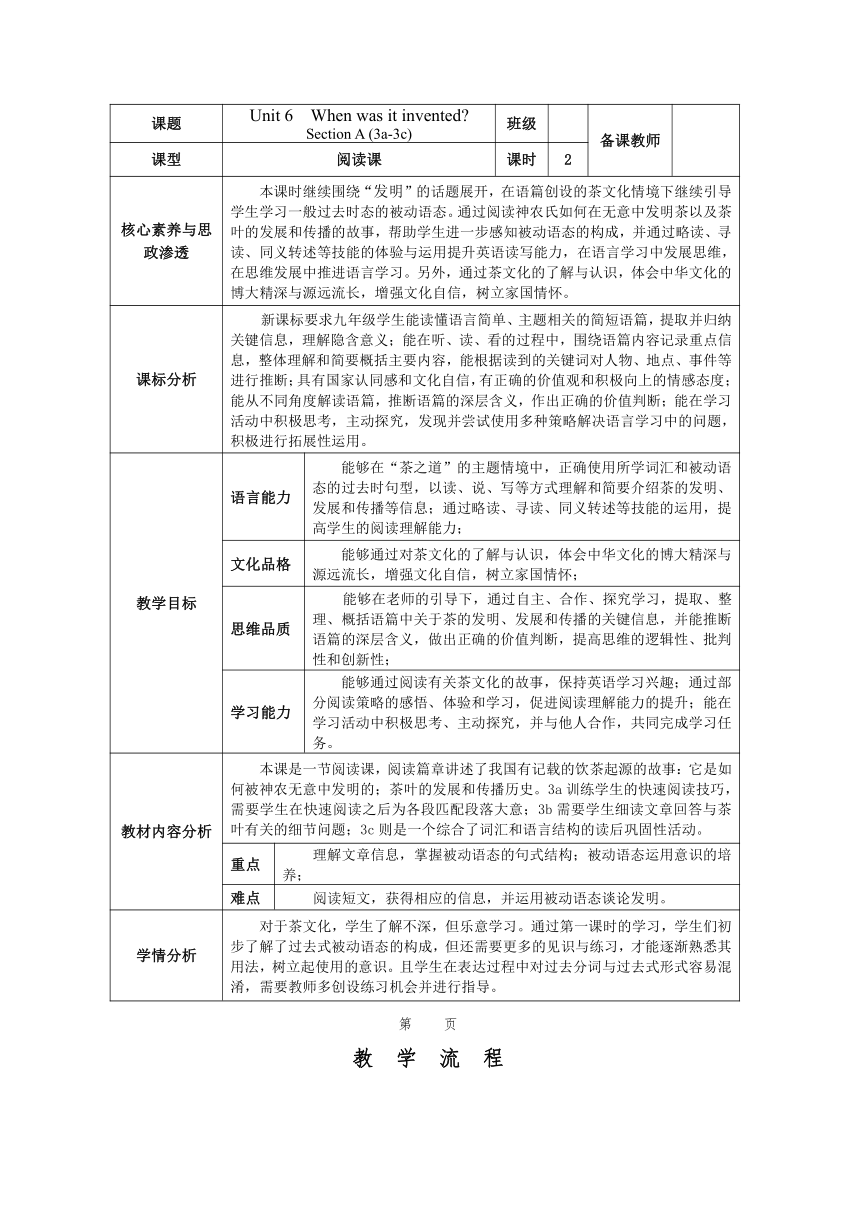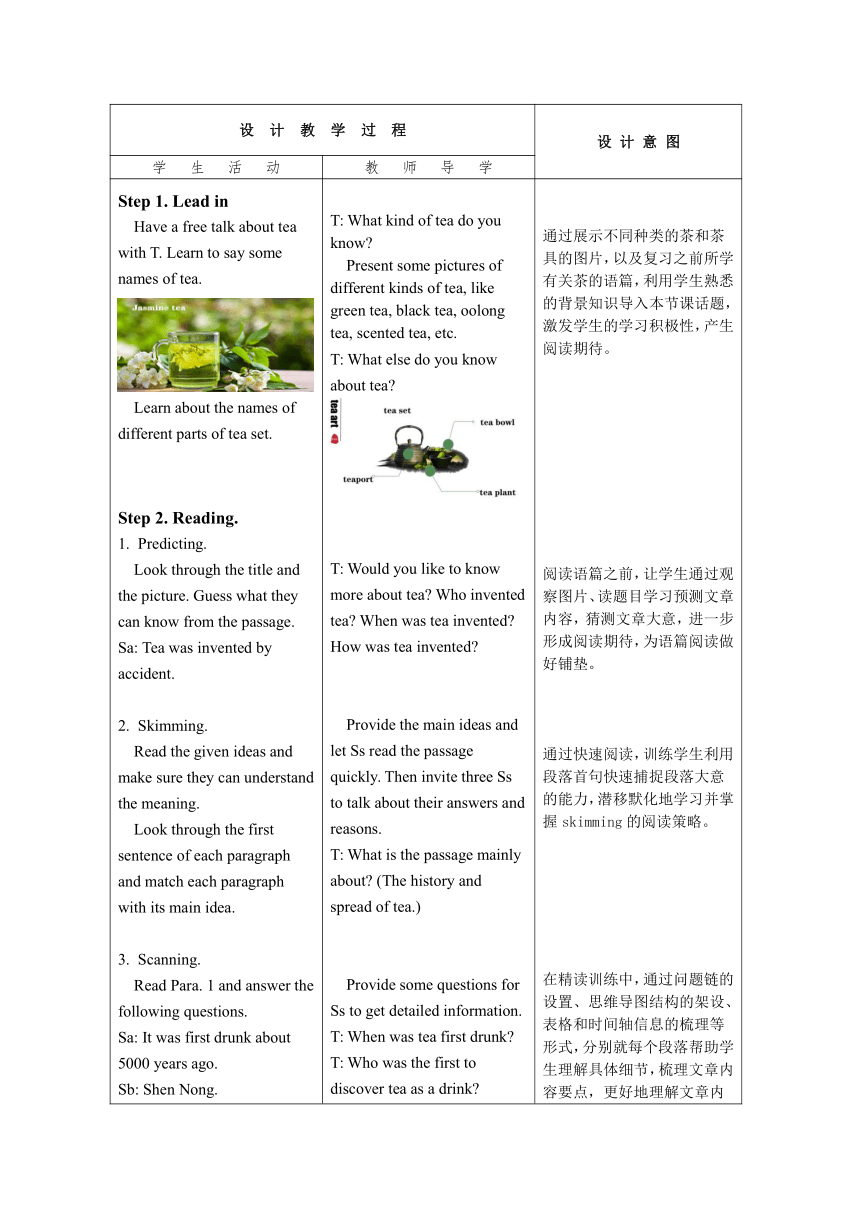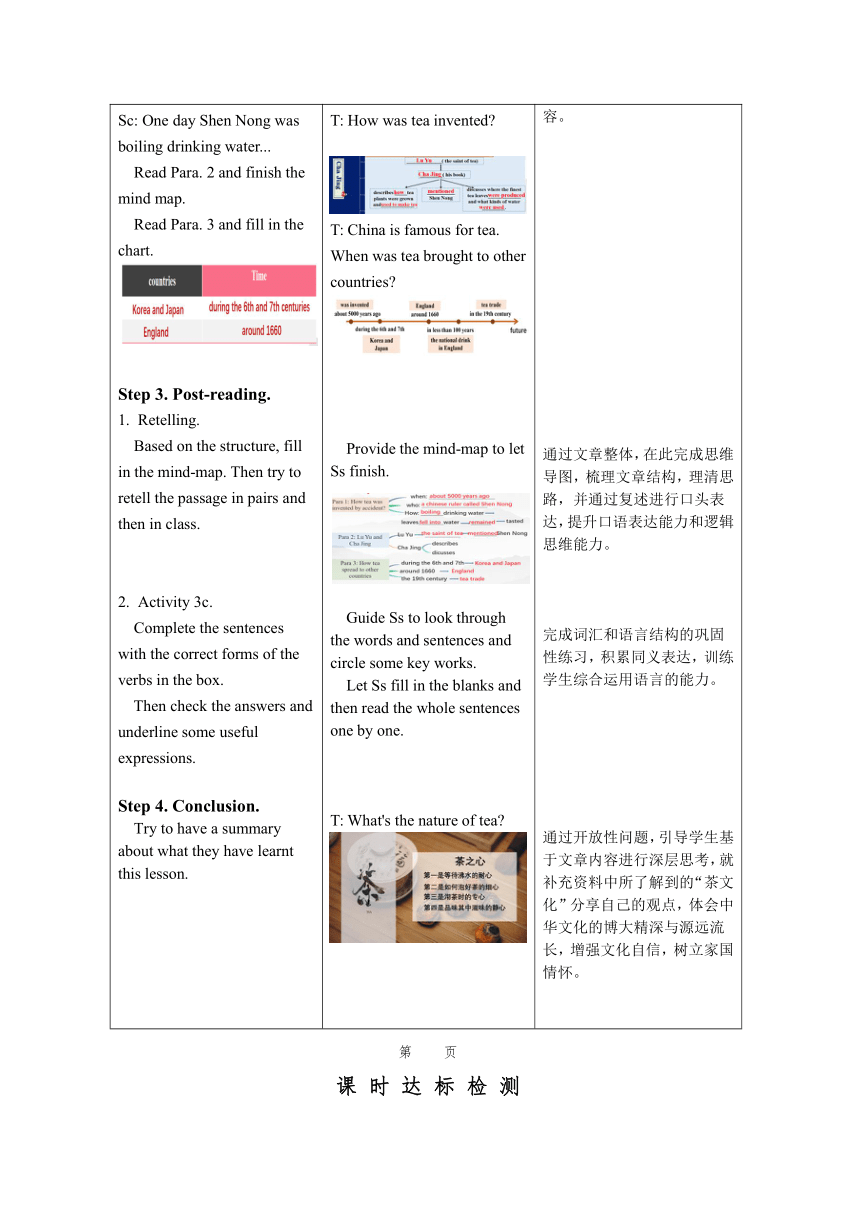【核心素养目标】Unit 6 When was it invented Section A (3a-3c) 表格式教案
文档属性
| 名称 | 【核心素养目标】Unit 6 When was it invented Section A (3a-3c) 表格式教案 |  | |
| 格式 | docx | ||
| 文件大小 | 1.1MB | ||
| 资源类型 | 教案 | ||
| 版本资源 | 人教新目标(Go for it)版 | ||
| 科目 | 英语 | ||
| 更新时间 | 2024-09-24 10:33:15 | ||
图片预览



文档简介
课题 Unit 6 When was it invented Section A (3a-3c) 班级 备课教师
课型 阅读课 课时 2
核心素养与思政渗透 本课时继续围绕“发明”的话题展开,在语篇创设的茶文化情境下继续引导学生学习一般过去时态的被动语态。通过阅读神农氏如何在无意中发明茶以及茶叶的发展和传播的故事,帮助学生进一步感知被动语态的构成,并通过略读、寻读、同义转述等技能的体验与运用提升英语读写能力,在语言学习中发展思维,在思维发展中推进语言学习。另外,通过茶文化的了解与认识,体会中华文化的博大精深与源远流长,增强文化自信,树立家国情怀。
课标分析 新课标要求九年级学生能读懂语言简单、主题相关的简短语篇,提取并归纳关键信息,理解隐含意义;能在听、读、看的过程中,围绕语篇内容记录重点信息,整体理解和简要概括主要内容,能根据读到的关键词对人物、地点、事件等进行推断;具有国家认同感和文化自信,有正确的价值观和积极向上的情感态度;能从不同角度解读语篇,推断语篇的深层含义,作出正确的价值判断;能在学习活动中积极思考,主动探究,发现并尝试使用多种策略解决语言学习中的问题,积极进行拓展性运用。
教学目标 语言能力 能够在“茶之道”的主题情境中,正确使用所学词汇和被动语态的过去时句型,以读、说、写等方式理解和简要介绍茶的发明、发展和传播等信息;通过略读、寻读、同义转述等技能的运用,提高学生的阅读理解能力;
文化品格 能够通过对茶文化的了解与认识,体会中华文化的博大精深与源远流长,增强文化自信,树立家国情怀;
思维品质 能够在老师的引导下,通过自主、合作、探究学习,提取、整理、概括语篇中关于茶的发明、发展和传播的关键信息,并能推断语篇的深层含义,做出正确的价值判断,提高思维的逻辑性、批判性和创新性;
学习能力 能够通过阅读有关茶文化的故事,保持英语学习兴趣;通过部分阅读策略的感悟、体验和学习,促进阅读理解能力的提升;能在学习活动中积极思考、主动探究,并与他人合作,共同完成学习任务。
教材内容分析 本课是一节阅读课,阅读篇章讲述了我国有记载的饮茶起源的故事:它是如何被神农无意中发明的;茶叶的发展和传播历史。3a训练学生的快速阅读技巧,需要学生在快速阅读之后为各段匹配段落大意;3b需要学生细读文章回答与茶叶有关的细节问题;3c则是一个综合了词汇和语言结构的读后巩固性活动。
重点 理解文章信息,掌握被动语态的句式结构;被动语态运用意识的培养;
难点 阅读短文,获得相应的信息,并运用被动语态谈论发明。
学情分析 对于茶文化,学生了解不深,但乐意学习。通过第一课时的学习,学生们初步了解了过去式被动语态的构成,但还需要更多的见识与练习,才能逐渐熟悉其用法,树立起使用的意识。且学生在表达过程中对过去分词与过去式形式容易混淆,需要教师多创设练习机会并进行指导。
第 页
教 学 流 程
设 计 教 学 过 程 设 计 意 图
学 生 活 动 教 师 导 学
Step 1. Lead in Have a free talk about tea with T. Learn to say some names of tea. Learn about the names of different parts of tea set. Step 2. Reading. Predicting. Look through the title and the picture. Guess what they can know from the passage. Sa: Tea was invented by accident. Skimming. Read the given ideas and make sure they can understand the meaning. Look through the first sentence of each paragraph and match each paragraph with its main idea. Scanning. Read Para. 1 and answer the following questions. Sa: It was first drunk about 5000 years ago. Sb: Shen Nong. Sc: One day Shen Nong was boiling drinking water... Read Para. 2 and finish the mind map. Read Para. 3 and fill in the chart. Step 3. Post-reading. Retelling. Based on the structure, fill in the mind-map. Then try to retell the passage in pairs and then in class. Activity 3c. Complete the sentences with the correct forms of the verbs in the box. Then check the answers and underline some useful expressions. Step 4. Conclusion. Try to have a summary about what they have learnt this lesson. T: What kind of tea do you know Present some pictures of different kinds of tea, like green tea, black tea, oolong tea, scented tea, etc. T: What else do you know about tea T: Would you like to know more about tea Who invented tea When was tea invented How was tea invented Provide the main ideas and let Ss read the passage quickly. Then invite three Ss to talk about their answers and reasons. T: What is the passage mainly about (The history and spread of tea.) Provide some questions for Ss to get detailed information. T: When was tea first drunk T: Who was the first to discover tea as a drink T: How was tea invented T: China is famous for tea. When was tea brought to other countries Provide the mind-map to let Ss finish. Guide Ss to look through the words and sentences and circle some key works. Let Ss fill in the blanks and then read the whole sentences one by one. T: What's the nature of tea 通过展示不同种类的茶和茶具的图片,以及复习之前所学有关茶的语篇,利用学生熟悉的背景知识导入本节课话题,激发学生的学习积极性,产生阅读期待。 阅读语篇之前,让学生通过观察图片、读题目学习预测文章内容,猜测文章大意,进一步形成阅读期待,为语篇阅读做好铺垫。 通过快速阅读,训练学生利用段落首句快速捕捉段落大意的能力,潜移默化地学习并掌握skimming的阅读策略。 在精读训练中,通过问题链的设置、思维导图结构的架设、表格和时间轴信息的梳理等形式,分别就每个段落帮助学生理解具体细节,梳理文章内容要点,更好地理解文章内容。 通过文章整体,在此完成思维导图,梳理文章结构,理清思路,并通过复述进行口头表达,提升口语表达能力和逻辑思维能力。 完成词汇和语言结构的巩固性练习,积累同义表达,训练学生综合运用语言的能力。 通过开放性问题,引导学生基于文章内容进行深层思考,就补充资料中所了解到的“茶文化”分享自己的观点,体会中华文化的博大精深与源远流长,增强文化自信,树立家国情怀。
第 页
课 时 达 标 检 测
Ⅰ.根据句意及汉语提示完成句子 —Do you know who was regarded as “the (圣人) of tea” —No, I don't. 2.The old man lost his life because of an (意外的) fire. 3.—Wow! How did the dog find the ball —By (嗅觉). 4.I've (几乎) finished reading the book Wonder. 5.From then on, the two countries' (贸易) greatly increased. Ⅱ.单项选择 ( )6. Last year, some of us to look after these young trees. asked B.were asked C.have asked ( )7. Molly found her father's ID card when she was tidying up the house. in person B.by accident C.by mistake ( )8. It discovered the 17th century. wasn't; until B.didn't; until C.didn't; before ( )9. —Simon, where do you want to eat — . I eat anything. I don't mind B.My pleasure C.Good idea ( )10. Han Meimei jumped so high that there was no about her winning. use B.doubt C.way Ⅲ.词语运用 serve, without, do, they, also, idea, meal, country, same, usual, when, make Tea is a popular drink around the world. But tea does not mean the 11. thing to everyone. In different countries people have different 12. about drinking tea. In China, for example, tea is always served 13. people get together. The Chinese drink it at any time of the day at home or in the teahouse. They prefer their tea 14. nothing in it. Tea is also important in Japan. The Japanese have a special way of 15. tea. It is very old and full of meanings. Everything must 16. in a special way. There is even a special room for it in Japan. Another tea-drinking 17. is Britain. In Britain, the late afternoon is “teatime”. Almost everyone has a cup of tea at that time. The British people 18. make tea in a teapot and drink it with milk and sugar. 19. also eat cakes, cookies and sandwiches at teatime. In the United States, people drink tea mostly for breakfast or after meals. Americans usually use tea bags 20. their tea. Tea bags are faster and easier than making tea in teapots. In summer, many Americans drink cold tea—“iced tea”.
第 页
课 时 教 学 设 计 尾 页
板 书 设 计
Unit 6 When was it invented (Section A 3a-3c)
作 业 设 计
Level A Besides tea, there are some other accidental inventions in the world. Search some information on them and write a short passage to introduce them to your classmates. The passive voice in past tense should be used.
Level B Draw a mind-map about tea based on the passage. The passive voice in past tense should be used.
教 学 反 思
第 页
课型 阅读课 课时 2
核心素养与思政渗透 本课时继续围绕“发明”的话题展开,在语篇创设的茶文化情境下继续引导学生学习一般过去时态的被动语态。通过阅读神农氏如何在无意中发明茶以及茶叶的发展和传播的故事,帮助学生进一步感知被动语态的构成,并通过略读、寻读、同义转述等技能的体验与运用提升英语读写能力,在语言学习中发展思维,在思维发展中推进语言学习。另外,通过茶文化的了解与认识,体会中华文化的博大精深与源远流长,增强文化自信,树立家国情怀。
课标分析 新课标要求九年级学生能读懂语言简单、主题相关的简短语篇,提取并归纳关键信息,理解隐含意义;能在听、读、看的过程中,围绕语篇内容记录重点信息,整体理解和简要概括主要内容,能根据读到的关键词对人物、地点、事件等进行推断;具有国家认同感和文化自信,有正确的价值观和积极向上的情感态度;能从不同角度解读语篇,推断语篇的深层含义,作出正确的价值判断;能在学习活动中积极思考,主动探究,发现并尝试使用多种策略解决语言学习中的问题,积极进行拓展性运用。
教学目标 语言能力 能够在“茶之道”的主题情境中,正确使用所学词汇和被动语态的过去时句型,以读、说、写等方式理解和简要介绍茶的发明、发展和传播等信息;通过略读、寻读、同义转述等技能的运用,提高学生的阅读理解能力;
文化品格 能够通过对茶文化的了解与认识,体会中华文化的博大精深与源远流长,增强文化自信,树立家国情怀;
思维品质 能够在老师的引导下,通过自主、合作、探究学习,提取、整理、概括语篇中关于茶的发明、发展和传播的关键信息,并能推断语篇的深层含义,做出正确的价值判断,提高思维的逻辑性、批判性和创新性;
学习能力 能够通过阅读有关茶文化的故事,保持英语学习兴趣;通过部分阅读策略的感悟、体验和学习,促进阅读理解能力的提升;能在学习活动中积极思考、主动探究,并与他人合作,共同完成学习任务。
教材内容分析 本课是一节阅读课,阅读篇章讲述了我国有记载的饮茶起源的故事:它是如何被神农无意中发明的;茶叶的发展和传播历史。3a训练学生的快速阅读技巧,需要学生在快速阅读之后为各段匹配段落大意;3b需要学生细读文章回答与茶叶有关的细节问题;3c则是一个综合了词汇和语言结构的读后巩固性活动。
重点 理解文章信息,掌握被动语态的句式结构;被动语态运用意识的培养;
难点 阅读短文,获得相应的信息,并运用被动语态谈论发明。
学情分析 对于茶文化,学生了解不深,但乐意学习。通过第一课时的学习,学生们初步了解了过去式被动语态的构成,但还需要更多的见识与练习,才能逐渐熟悉其用法,树立起使用的意识。且学生在表达过程中对过去分词与过去式形式容易混淆,需要教师多创设练习机会并进行指导。
第 页
教 学 流 程
设 计 教 学 过 程 设 计 意 图
学 生 活 动 教 师 导 学
Step 1. Lead in Have a free talk about tea with T. Learn to say some names of tea. Learn about the names of different parts of tea set. Step 2. Reading. Predicting. Look through the title and the picture. Guess what they can know from the passage. Sa: Tea was invented by accident. Skimming. Read the given ideas and make sure they can understand the meaning. Look through the first sentence of each paragraph and match each paragraph with its main idea. Scanning. Read Para. 1 and answer the following questions. Sa: It was first drunk about 5000 years ago. Sb: Shen Nong. Sc: One day Shen Nong was boiling drinking water... Read Para. 2 and finish the mind map. Read Para. 3 and fill in the chart. Step 3. Post-reading. Retelling. Based on the structure, fill in the mind-map. Then try to retell the passage in pairs and then in class. Activity 3c. Complete the sentences with the correct forms of the verbs in the box. Then check the answers and underline some useful expressions. Step 4. Conclusion. Try to have a summary about what they have learnt this lesson. T: What kind of tea do you know Present some pictures of different kinds of tea, like green tea, black tea, oolong tea, scented tea, etc. T: What else do you know about tea T: Would you like to know more about tea Who invented tea When was tea invented How was tea invented Provide the main ideas and let Ss read the passage quickly. Then invite three Ss to talk about their answers and reasons. T: What is the passage mainly about (The history and spread of tea.) Provide some questions for Ss to get detailed information. T: When was tea first drunk T: Who was the first to discover tea as a drink T: How was tea invented T: China is famous for tea. When was tea brought to other countries Provide the mind-map to let Ss finish. Guide Ss to look through the words and sentences and circle some key works. Let Ss fill in the blanks and then read the whole sentences one by one. T: What's the nature of tea 通过展示不同种类的茶和茶具的图片,以及复习之前所学有关茶的语篇,利用学生熟悉的背景知识导入本节课话题,激发学生的学习积极性,产生阅读期待。 阅读语篇之前,让学生通过观察图片、读题目学习预测文章内容,猜测文章大意,进一步形成阅读期待,为语篇阅读做好铺垫。 通过快速阅读,训练学生利用段落首句快速捕捉段落大意的能力,潜移默化地学习并掌握skimming的阅读策略。 在精读训练中,通过问题链的设置、思维导图结构的架设、表格和时间轴信息的梳理等形式,分别就每个段落帮助学生理解具体细节,梳理文章内容要点,更好地理解文章内容。 通过文章整体,在此完成思维导图,梳理文章结构,理清思路,并通过复述进行口头表达,提升口语表达能力和逻辑思维能力。 完成词汇和语言结构的巩固性练习,积累同义表达,训练学生综合运用语言的能力。 通过开放性问题,引导学生基于文章内容进行深层思考,就补充资料中所了解到的“茶文化”分享自己的观点,体会中华文化的博大精深与源远流长,增强文化自信,树立家国情怀。
第 页
课 时 达 标 检 测
Ⅰ.根据句意及汉语提示完成句子 —Do you know who was regarded as “the (圣人) of tea” —No, I don't. 2.The old man lost his life because of an (意外的) fire. 3.—Wow! How did the dog find the ball —By (嗅觉). 4.I've (几乎) finished reading the book Wonder. 5.From then on, the two countries' (贸易) greatly increased. Ⅱ.单项选择 ( )6. Last year, some of us to look after these young trees. asked B.were asked C.have asked ( )7. Molly found her father's ID card when she was tidying up the house. in person B.by accident C.by mistake ( )8. It discovered the 17th century. wasn't; until B.didn't; until C.didn't; before ( )9. —Simon, where do you want to eat — . I eat anything. I don't mind B.My pleasure C.Good idea ( )10. Han Meimei jumped so high that there was no about her winning. use B.doubt C.way Ⅲ.词语运用 serve, without, do, they, also, idea, meal, country, same, usual, when, make Tea is a popular drink around the world. But tea does not mean the 11. thing to everyone. In different countries people have different 12. about drinking tea. In China, for example, tea is always served 13. people get together. The Chinese drink it at any time of the day at home or in the teahouse. They prefer their tea 14. nothing in it. Tea is also important in Japan. The Japanese have a special way of 15. tea. It is very old and full of meanings. Everything must 16. in a special way. There is even a special room for it in Japan. Another tea-drinking 17. is Britain. In Britain, the late afternoon is “teatime”. Almost everyone has a cup of tea at that time. The British people 18. make tea in a teapot and drink it with milk and sugar. 19. also eat cakes, cookies and sandwiches at teatime. In the United States, people drink tea mostly for breakfast or after meals. Americans usually use tea bags 20. their tea. Tea bags are faster and easier than making tea in teapots. In summer, many Americans drink cold tea—“iced tea”.
第 页
课 时 教 学 设 计 尾 页
板 书 设 计
Unit 6 When was it invented (Section A 3a-3c)
作 业 设 计
Level A Besides tea, there are some other accidental inventions in the world. Search some information on them and write a short passage to introduce them to your classmates. The passive voice in past tense should be used.
Level B Draw a mind-map about tea based on the passage. The passive voice in past tense should be used.
教 学 反 思
第 页
同课章节目录
- Unit 1 How can we become good learners.
- Section A
- Section B
- Unit 2 I think that mooncakes are delicious!
- Section A
- Section B
- Unit 3 Could you please tell me where the restroom
- Section A
- Section B
- Unit 4 I used to be afraid of the dark.
- Section A
- Section B
- Unit 5 What are the shirts made of?
- Section A
- Section B
- Review of Units 1-5
- Unit 6 When was it invented?
- Section A
- Section B
- Unit 7 Teenagers should be allowed to choose their
- Section A
- Section B
- Unit 8 It must belong to Carla.
- Section A
- Section B
- Unit 9 I like music that I can dance to.
- Section A
- Section B
- Unit 10 You're supposed to shake hands.
- Section A
- Section B
- Review of Units 6-10
- Unit 11 Sad movies make me cry.
- Section A
- Section B
- Unit 12 Life is full of the unexpected
- Section A
- Section B
- Unit 13 We're trying to save the earth!
- Section A
- Section B
- Unit 14 I remember meeting all of you in Grade 7.
- Section A
- Section B
- Review of Units 11-14
